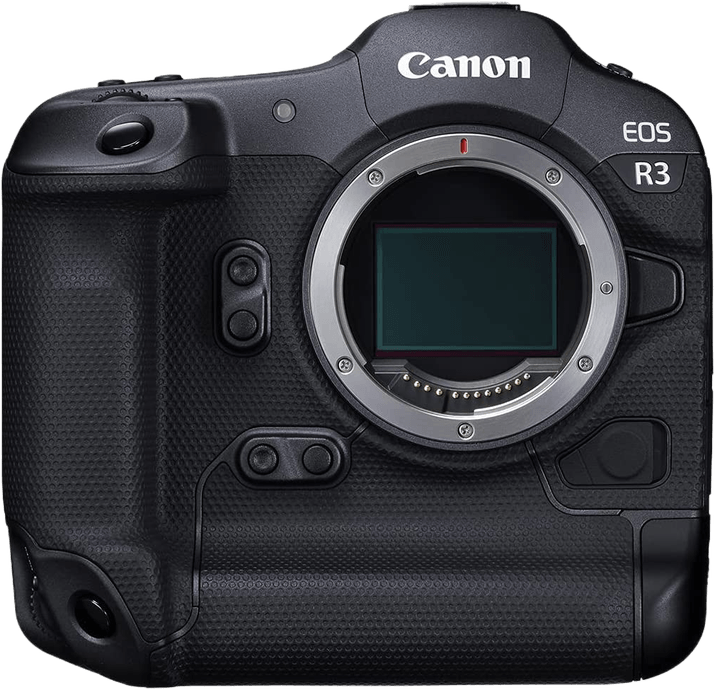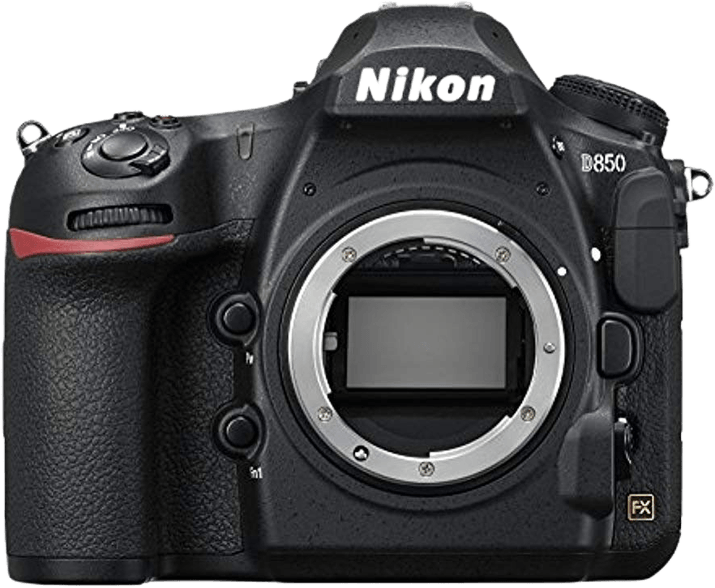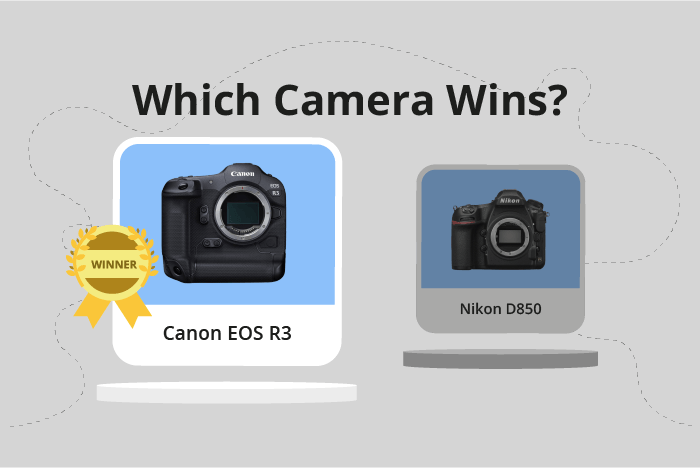Canon EOS R3 vs Nikon D850 Comparison
Canon EOS R3

Nikon D850

The Canon EOS R3 takes the lead with a score of 84/100, while the Nikon D850 trails close behind at 82/100. Both cameras share similarities, such as their high-quality build and similar weight, with the EOS R3 weighing 1015g and the D850 weighing 1005g. Their dimensions are also comparable, with the EOS R3 measuring 150 x 143 x 87mm and the D850 at 146 x 124 x 79mm.
The Canon EOS R3 outshines the Nikon D850 with its cutting-edge mirrorless technology and recent release in 2021. This advanced camera also justifies its higher launch price of $5999, compared to the D850’s $3300 in 2017.
However, the Nikon D850 still holds its ground with its DSLR capabilities and more affordable price, making it an attractive option for those on a budget or who prefer a DSLR.
Taking these factors into account, the Canon EOS R3 emerges as the superior camera based on its higher score and advanced mirrorless technology. However, the Nikon D850 remains a worthy contender for those seeking a more budget-friendly DSLR option.
Canon EOS R3 vs Nikon D850 Overview and Optics
The Canon EOS R3 outperforms the Nikon D850 in optics with a score of 84/100, while the Nikon D850 scores 79/100. Both cameras share some common specifications, such as CMOS sensor type, full-frame sensor size, and their respective brand-specific lens mounts – Canon RF and Nikon F FX.
The Canon EOS R3 excels in shooting speed, reaching 30 frames per second, which is significantly faster than the Nikon D850’s 7 frames per second. This advantage allows the EOS R3 to capture fast-moving subjects with ease. Additionally, the EOS R3 features image stabilization, which helps reduce camera shake and enhance image quality in low-light situations or when using slower shutter speeds. The superior DIGIC X processor in the EOS R3 also contributes to its overall performance.
On the other hand, the Nikon D850 boasts a higher megapixel count of 45.7, compared to the EOS R3’s 24 megapixels. This difference results in larger, more detailed images, which may be beneficial for photographers who require high-resolution output. Furthermore, the D850’s sensor has a higher DXOMARK score of 100, indicating better overall image quality compared to the EOS R3’s score of 96.
In terms of optics, the Canon EOS R3’s faster shooting speed, image stabilization, and advanced processor make it a strong contender, particularly for action and sports photography. However, the Nikon D850’s higher megapixel count and superior sensor quality should not be overlooked, as they can provide exceptional image detail and quality for landscape or portrait photography. Ultimately, the choice between these two cameras depends on the specific needs and preferences of the photographer.
Canon EOS R3 vs Nikon D850 Video Performance
The Canon EOS R3 outperforms the Nikon D850 in video capabilities with a score of 96/100 compared to the D850’s 70/100. Both cameras share some common specs, such as built-in time-lapse functionality. However, the EOS R3 offers superior video features that contribute to its higher score.
The EOS R3 boasts a maximum video resolution of 6K (6000 x 3164), while the D850 only reaches 4K (3840 x 2160). This difference in resolution results in sharper and more detailed footage from the EOS R3. Additionally, the EOS R3 supports a maximum video frame rate of 120fps, enabling smoother slow-motion capture. In contrast, the D850’s maximum frame rate is 30fps, limiting its slow-motion capabilities.
Despite its lower score, the Nikon D850 still offers quality video performance. Its 4K resolution is sufficient for most purposes, and the built-in time-lapse functionality is a valuable feature for both cameras. However, the EOS R3’s higher resolution and frame rate provide a noticeable advantage in video capabilities.
In comparing the two cameras, the Canon EOS R3 emerges as the clear winner in terms of video performance. With its 6K resolution and 120fps frame rate, it delivers superior video quality and slow-motion capabilities. While the Nikon D850 is a capable camera with 4K resolution and time-lapse functionality, it falls short in comparison to the EOS R3’s advanced features. Users seeking the best video capabilities should opt for the Canon EOS R3.
Canon EOS R3 vs Nikon D850 Features and Benefits
The Canon EOS R3 and Nikon D850 both have a feature score of 87/100. These cameras share several specifications, such as screen size (3.2 inches), touchscreen capabilities, WiFi, and Bluetooth connectivity. However, there are differences between the two cameras that make one better than the other in certain aspects.
The Canon EOS R3 outperforms the Nikon D850 in terms of its screen resolution and flip screen feature. The EOS R3 boasts a screen resolution of 4,150,000 dots, which is significantly higher than the D850’s 2,359,000 dots. This higher resolution allows for better image quality when reviewing photos and navigating menus. Additionally, the EOS R3 has a flip screen, providing more flexibility for shooting at various angles, while the D850 lacks this feature.
On the other hand, the Nikon D850 has an advantage over the Canon EOS R3 in the absence of GPS capabilities. The D850 does not have a built-in GPS, which could be beneficial for photographers who prefer not to have their location data stored or those who want to save battery life.
In terms of shared features, both cameras have a 3.2-inch touchscreen, allowing for easy navigation and control. They also have WiFi and Bluetooth connectivity, enabling photographers to transfer images wirelessly and control the camera remotely.
Considering the differences and similarities, the Canon EOS R3 offers a better screen resolution and flip screen feature, making it more versatile in various shooting situations. However, the Nikon D850 might be more suitable for those who prefer not to have GPS capabilities. Ultimately, the choice between these two cameras depends on the individual photographer’s needs and preferences.
Canon EOS R3 vs Nikon D850 Storage and Battery
The Nikon D850 wins in the storage and battery category with a score of 84/100, compared to the Canon EOS R3’s 81/100. Both cameras share common features such as having two memory card slots and accepting SD/SDHC/SDXC cards. The Nikon D850’s edge comes from its impressive battery life of 1840 shots, more than double the Canon EOS R3’s 760 shots. Additionally, the Nikon D850 uses the EN-EL15a battery type, while the Canon EOS R3 relies on the LP-E19 battery.
However, the Canon EOS R3 holds an advantage in that it supports USB charging, which the Nikon D850 lacks. This feature provides added convenience for users who need to charge their camera on-the-go. Despite its lower score, the Canon EOS R3 offers a unique benefit in terms of charging options.
Taking these factors into account, the Nikon D850 stands out for its superior battery life, while the Canon EOS R3 offers the convenience of USB charging. Both cameras have their merits in the storage and battery department, and the choice ultimately depends on the user’s priorities and preferences.
Canon EOS R3 vs Nikon D850 – Our Verdict
Are you still undecided about which camera is right for you? Have a look at these popular comparisons that feature the Canon EOS R3 or the Nikon D850:

